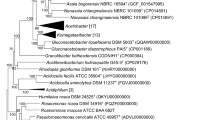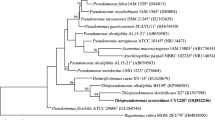Abstract
H2-oxidizing CO2-reducing acetogenic bacteria were isolated from gut contents of Nasutitermes nigriceps termites. Isolates were strictly anaerobic, Gram negative, endospore-forming, straight to slightly curved rods (0.5–0.8×2–8 μm) that were motile by means of lateral flagella. Cells were oxidase negative, but catalase positive and possessed a b-type cytochrome(s) associated with the cell membrane. Cells grew anaerobically with H2+CO2 as energy source and catalyzed a total synthesis of acetate from this gas mixture. H2 uptake by a representative isolate (strain JSN-2) displayed a K m=6 μM and V max=380 nmol x min-1 x mg protein-1. Other substrates used as energy sources for growth and acetogenesis included CO, methanol, betaine, trimethoxybenzoate, and various other organic acids. Succinate was also fermented, but propionate was formed from this substrate instead of acetate. Of a variety of sugars and sugar alcohols tested, only mannitol supported growth. Cells grew optimally at 30° C and pH 7.2 and required yeast extract or a source of amino acids (e.g. Casamino acids) for good growth. During initial enrichment and isolation, cells appeared sensitive to various reducing agents commonly employed in media for anaerobes. The DNA base composition of strain JSN-2 was 48.6 mol% G+C. On the bases of cell morphology, substrate utilization spectrum, and DNA base composition, strain JSN-2 is here-with proposed as the type strain of the new species Sporomusa termitida.
Similar content being viewed by others
References
Barker SB (1957) Preparation and colorimetric determination of lactic acid. In: Colowick SP, Kaplan NO (eds) Methods in enzymology, vol 3. Academic Press Inc., New York, pp 241–246
Braun K, Gottschalk G (1981) Effect of molecular hydrogen and carbon dioxide on chemo-organotrophic growth of Acetobacterium woodii and Clostridium aceticum. Arch Microbiol 128:294–298
Breznak JA, Pankratz HS (1977) In situ morphology of the gut microbiota of wood-eating termites [Reticulitermes flavipes (Kollar) and Coptotermes formosanus Shiraki]. Appl Environ Microbiol 33:406–426
Breznak JA, Switzer JM (1986) Acetate synthesis from H2 plus CO2 by termite gut microbes. Appl Environ Microbiol 52:623–630
Brock TD, O'Dea K (1977) Amorphous ferrous sulfide as a reducing agent for culture of anaerobes. Appl Environ Microbiol 33:254–256
Conrad R, Phelps TJ, Zeikus JG (1985) Gas metabolism evidence in support of the juxtapositioning of hydrogen-producing and methanogenic bacteria in sewage sludge and lake sediments. Appl Environ Microbiol 50:595–601
Costilow R (1981) Biophysical factors in growth. In: Gerhardt P (ed) Manual of methods for general bacteriology, chapter 6. American Society for Microbiology. Washington, DC
Flossdorf J (1983) A rapid method for the determination of the base composition of bacterial DNA. J Microbiol Meth 1:305–311
Hager LP, Itagaki E (1967) The preparation and properties of cytochrome b 562 from Escherichia coli. In: Estabrook RW, Pullman ME (eds) Methods in enzymology, vol 10. Academic Press, Inc., New York, pp 373–378
Hanson RS, Phillips JA (1981) Chemical composition. In: Gerhardt P (ed) Manual of methods for general bacteriology, chapter 17. Am Soc Microbiol, Washington, DC
Hermann M, Popoff M-R, Sebald M (1987) Sporomusa paucivorans sp. nov., a methylotrophic bacterium that forms acetic acid from hydrogen and carbon dioxide. Int J Syst Bacteriol, 73:93–101
Hungate RE, Smith W, Bauchop T, Yu J, Rabinowitz JC (1970) Formate as an intermediate in the bovine rumen fermentation. J Bacteriol 102:389–397
Kerby R, Zeikus JG (1987) Anaerobic catabolism of formate to acetate and CO2 by Butyribacterium methylotrophicum. J Bacteriol 169:2063–2068
Kristjansson JK, Schönheit P, Thauer RK (1982) Different K s values for hydrogen of methanogenic bacteria and sulfate reducing bacteria: an explanation for the apparent inhibition of methanogenesis by sulfate. Arch Microbiol 131:278–282
Lewis JC (1967) Determination of dipicolinic acid in bacterial spores by ultraviolet spectrometry of the calcium chelate. Anal Biochem 19:327–337
Lewis DH, Harley JL (1965) Carbohydrate physiology of mycorrhizal roots of beech. I. Identity of endogenous sugars and utilization of exogenous sugars. New Phytol 64:224–237
Marier JR, Boulet M (1958) Direct determination of citric acid in milk with an improved pyridine acetic anhydride method. J Dairy Sci 41:1683–1692
Möller B, Ossmer R, Howard BH, Gottschalk G, Hippe H (1984) Sporomusa, a new genus of Gram-negative anaerobic bacteria including Sporomusa sphaeroides spec. nov. and Sporomusa ovata spec. nov. Arch Microbiol 139:388–396
Odelson DA, Breznak, JA (1983) Volatile fatty acid production by the hindgut microbiota of xylophagous termites. Appl Environ Microbiol 45:1602–1613
Ollivier B, Cordruwisch R, Lombardo A, Garcia J-L (1985) Isolation and characterization of Sporomusa acidovorans sp. nov., a methylotrophic homoacetogenic bacterium. Arch Microbiol 142:307–310
Potrikus CJ, Breznak JA (1977) Nitrogen-fixing Enterobacter agglomerans isolated from guts of wood-eating termites. Appl Environ Microbiol 33:392–399
Robinson JA, Tiedje JM (1984) Competition between sulfate-reducing and methanogenic bacteria for H2 under resting and growing conditions. Arch Microbiol 137:26–32
Schauer NL, Ferry JG (1980) Metabolism of formate in Methanobacterium formicicum. J Bacteriol 142:800–807
Schauer NL, Brown DP, Ferry JG (1982) Kinetics of formate metabolism in Methanobacterium formicicum and Methanospirillum hungatei. Appl Environ Microbiol 44:549–554
Schink B, Pfennig N (1982) Propionigenium modestum gen. nov. sp. nov. a new strictly anaerobic, nonsporing bacterium growing on succinate. Arch Microbiol 133:209–216
Schultz JE, Breznak JA (1979) Cross-feeding of lactate between Streptococcus lactis and Bacteroides sp. isolated from termite hindguts. Appl Environ Microbiol 37:1206–1210
Seiler W (1978) The influence of the biosphere on the atmosperic CO and H2 cycles. In: Krumbein W (ed) Environmental biogeochemistry and geomicrobiology, vol 3. Ann Arbor Scientific Publishers, Ann Arbor, Michigan, pp 773–810
Seiler W, Giehl H, Roggendorf P (1980) Detection of carbon monoxide and hydrogen by conversion of mercury oxide to mercury vapor. Atmos Technol 12:40–45
Widdel F, Pfennig N (1984) Dissimilatory sulfate- or sulfur-reducing bacteria. In: Krieg NR, Holt JG (eds) Bergey's manual of systematic bacteriology, vol 1. Williams and Wilkins, Baltimore London, pp 663–679
Widdel F, Kohring G-W, Mayer F (1983) Studies on dissimilatory sulfate-reducing bacteria that decompose fatty acids. III. Characterization of the filamentous gliding Desulfonema limicola gen. nov. sp. nov., and Desulfonema magnum sp. nov. Arch Microbiol 134:286–294
Zehnder AJB, Wuhrmann K (1976) Titanium (III) citrate as a nontoxic oxidation-reduction buffering system for the culture of obligate anaerobes. Science 194:1165–1166
Author information
Authors and Affiliations
Additional information
Journal article no. 12513 from the Michigan Agricultural Experiment Station
Rights and permissions
About this article
Cite this article
Breznak, J.A., Switzer, J.M. & Seitz, H.J. Sporomusa termitida sp. nov., an H2/CO2-utilizing acetogen isolated from termites. Arch. Microbiol. 150, 282–288 (1988). https://doi.org/10.1007/BF00407793
Received:
Accepted:
Issue Date:
DOI: https://doi.org/10.1007/BF00407793




